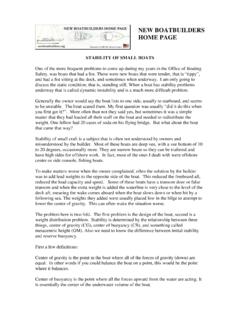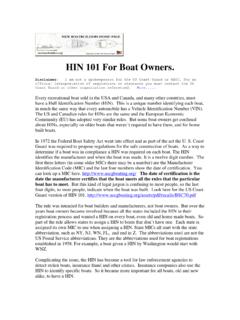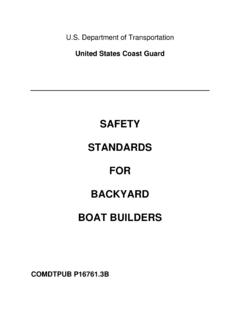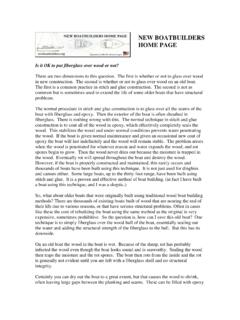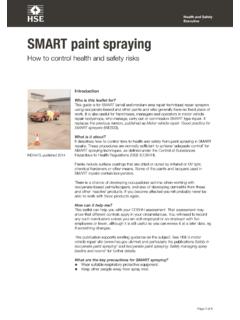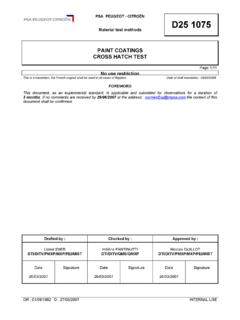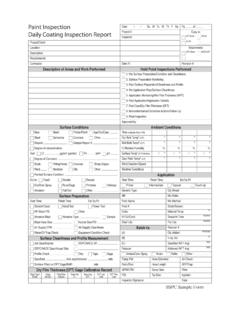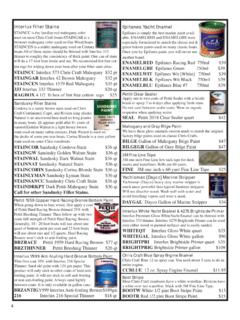Transcription of Aluminum: To Paint Or Not To Paint - …
1 Aluminum Boats and Tanks: To Paint Or Not To Paint ? I am frequently asked: Should I Paint my aluminum fuel tank? What do I use to Paint it? How do I do it? These questions also relate to painting aluminum boats. How do I Paint my aluminum boat? I see that question on many boating forums. The answer is not that simple. Aluminum tanks and boats have the same qualities and so require the same procedures for painting. Aluminum used in boats and tanks has to be tough and durable and also be able to take a dent without breaking. The grade of aluminum used in the marine environments is usually in the 5000 and 6000 series. Tanks should be 5052, 5083 or 5086. The reason, without getting into chemistry and metallurgy, is that these aluminum series are very corrosion resistant and least affected by salt water and other corrosives found in the marine environment. At the same time they have the strength and elasticity for use on boats. Aluminum is one of the best metals for marine use.
2 Bare aluminum forms an aluminum oxide coating on its surface that creates a barrier and prevents the metal from corroding. Wipe away the oxide, or even scratch it and the metal will begin to corrode. However, the aluminum oxide coating is self-repairing. If the metal is kept clean and dry the oxide will reform and again protect the metal. For this reason aluminum tanks and boats are generally not painted. In fact aluminum tanks are almost never painted. It is best to leave tanks bare. Tanks are usually out of the weather in a protected compartment, and painting the tank will not give it any more protection than not painting it. The process for painting aluminum is so complex that painting a fuel tank is simply not worth the trouble. On the other hand, aluminum boats can become rather shabby looking after years of use so owners often want to Paint them and spruce them up. Some boat manufacturers Paint their aluminum boats to make them more attractive and stylish.
3 When done by a professional in the factory these finishes can last for many years. But if not applied correctly the Paint will soon begin to chip and peel and look worse than the bare aluminum. So, people who want to do it themselves, or have a boat painted by a professional shop, need to know just what process needs to be used to get a quality, lasting finish that will look good and last for many years. It comes back to the oxide coating. Most Paint simply will not adhere to aluminum because of the oxide coating. So the metal must be prepared to accept Paint . This involves five steps. These are not necessarily in order. 1. Cleaning and removing dirt, Paint , oils, grease, and anything else on the metal. 2. Chemically removing the oxide. 3. Priming the surface with a coating that will accept the Paint 4. Several rinses with fresh water 5. Painting with a compatible Paint . I am not going to go into this in detail because I am not an expert on painting metal surfaces.
4 But there are many web sites that explain it well enough for the DIY boat owner to do it. Michael Kasten: Aluminum For Boats: : Painting Aluminum: Paintings and Coatings Resource Center: Federal MIL spec on Painting Aluminum MIL-DTL-5541F Chemical Conversion Coatings on Aluminum and Aluminum Alloys. Buzzle on Painting Aluminum Yahoo Voices Painting and Aluminum Boat: The following links require membership in a forum or web site to view the articles. Membership is free, but you must register to become a member. The Metal Boat Society: Preparing Aluminum For Coating: +alu minum The Metal Boat Society: Paint for Aluminum Boat: +alum inum Expert Witness: Painting Aluminum Expert Witness: Painting Aluminum Aircraft, Outboard Motors, Decks, Houses, Etc. Iboats: Aluminum Boat Forum Videos on Youtube: How to Paint an Aluminum Duck Boat Part 1: How to Paint an Aluminum Duck Boat Part 2: So what about aluminum fuel tanks? Is aluminum a good, safe, long lasting material for tanks?
5 In a research project conducted by Underwriters Laboratories for the US Coast Guard they found that the average life of an aluminum tank was ten years. This can be extended considerably. I have seen aluminum tanks 20 years old that are still in good condition. Aluminum is a very suitable material for fuel tanks in boats, as long as they are installed correctly, mounted properly, and inspected regularly. The enemy of all metal tanks is water. Any metal tank should be mounted so that moisture will not collect on any surface. One of the most common mistakes is mounting a metal tank on a sheet of plywood, foam, rubber or some other material that absorbs moisture. The moisture dissolves the oxide and corrodes the bottom of the tank. Ideally the tank should have air circulating around it on all sides including the top and bottom. To allow air under the tank requires using brackets that raise the tank above the mounting surface. This is by far the best way to mount an aluminum tank.
6 A common practice is to use a non-moisture absorbing material, such as neoprene on which to sit the tank. I, however, do not favor this. I believe that moisture can still collect between the neoprene and the tank, but this is a controversial subject and others may disagree. Another common mistake is foaming the tank in. There are Federal Regulations and American Boat and Yacht Council (ABYC) standards that must be met to foam in a tank. One of the most significant of these is that the foam must bond tightly to the surfaces of the tank. This is to prevent any moisture from collecting between the foam and the tank wall. The requirement is that the bond strength between the foam and the tank must be greater than the sheer strength of the foam. This means that the foam itself will break under stress before the adhesive bond breaks. In reality this is almost never achievable because the builders rarely prepare the aluminum surface to accept the foam.
7 Foam does not bond well to aluminum oxide. Aluminum must be prepared to accept foam in the same way as it is prepared for Paint , so the bond fails, moisture collects on the tank, and the tank corrodes. Another requirement is that the foam cannot be the sole source of support for the tank. In other words, the tank must be independently mounted. On outboard powered boats this is rarely done because the Federal Regulations for tanks do not apply to outboard boats. So you see many outboard boats with foamed in tanks, and the tanks fail long before the average life span. However, the ABYC standard does apply to outboard boats; so on boats manufactured to ABYC standards you rarely ever see foamed in tanks. Another common error is burying the tank under a sole or behind a bulkhead where it cannot be seen and cannot be inspected. This also makes it very difficult to remove and replace. I have heard far too many horror stories from boat owners about how they had to take the boat apart to replace the tank.
8 If a tank is mounted properly, easy to get to and inspect, it will probably last 10 to 20 years without leaking Last but not least, many aluminum tanks on small boats are installed as low in the boat as possible, usually in the bilge. On many boats built today the builders do not put limber holes in the bulkheads to drain collected water out of compartments. So water collects under the tank, and while it is on the trailer, or underway, the water sloshes around and wets the tank on the bottom and sides. Often the boat sits outside on the trailer over the winter, with no cover, and rain and snow collect, causing the tank to stand in water for a long time. The boats should be covered and the trailer tilted up so water can drain to the stern. The fuel tank compartment should have a drain so water can drain back to the stern where there is a boat plug or a bilge pump that gets rid of the water. The whole point is to keep the bilge and the tank dry.
9 What about Ethanol? Does it have an effect on aluminum tanks? See Much Ado About Ethanol. It has been known for years that aluminum tanks can corrode from the inside out due to alcohol in the fuel. If the tank is left in storage for many months phase separation can occur, resulting in separate layers of fuel, alcohol and water in the tank. Acidic compounds form at the boundary between the water and alcohol and this corrodes the tank. The acids cause pinholes to develop in the bottom of the tank. Boats left in storage over the winter with full tanks have been found in the spring with empty tanks and full bilges. So care must be taken to properly store your boat. Tanks should be stored empty, or if being stored for only a few months, co-inhibitors and stabilizers can be added to the fuel to prevent phase separation. If you store the tank this way, it should be completely full to prevent moisture from condensing in the tank. But the best way is to store the boat with empty tanks to protect the aluminum tank from inside corrosion.
10 The American Boat and Yacht Council (ABYC) ( ) publishes a standard for gasoline fuel systems: H-24 Gasoline Fuel Systems. This standard has specifications for fuel tanks including type of material, thickness and various tests the tank must be able to pass. This standard includes the Federal Regulations for fuels systems as well. ( ). The Canadian and Australian Standards are based on the ABYC Standards and are very similar to the European standards for fuel systems. The standard also contains specific requirements for the installation of the tank. ABYC also has a standard for Diesel Fuel systems, H-33 Diesel Fuel Systems, which includes diesel fuel tanks. Meeting these requirements can significantly increase the life of the fuel tank and the safety of the boat. Copyright 2008 New Boat Builders Home Page Revised 09/10/2012 All Rights Reserv
